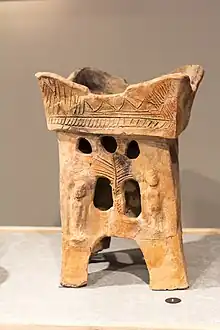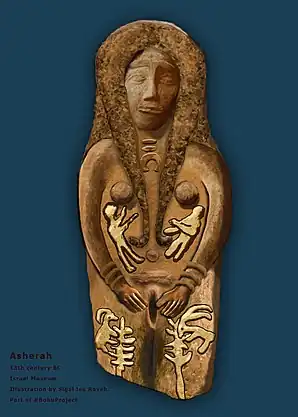Asherah pole
An Asherah pole is a sacred tree or pole that stood near Canaanite religious locations to honor the goddess Asherah.[1] The relation of the literary references to an asherah and archaeological finds of Judaean pillar-figurines has engendered a literature of debate.[2]

The asherim were also cult objects related to the worship of Asherah, the consort of either Ba'al or, as inscriptions from Kuntillet ‘Ajrud and Khirbet el-Qom attest, Yahweh,[3] and thus objects of contention among competing cults. In translations of the Hebrew Bible that render the Hebrew asherim (אֲשֵׁרִים ’ăšērīm) or asheroth (אֲשֵׁרוֹת ’ăšērōṯ) into English as "Asherah poles", the insertion of "pole" begs the question by setting up unwarranted expectations for such a wooden object: "we are never told exactly what it was", observes John Day.[4] The traditional interpretation of the Biblical text is that the Israelites imported pagan elements such as the Asherah poles from the surrounding Canaanites. In light of archeological finds, however, modern scholars now theorize that the Israelite folk religion was Canaanite in its inception and always polytheistic; this theory holds that the innovators were the prophets and priests who denounced the Asherah poles.[5] Such theories inspire ongoing debate.[6]
References from the Hebrew Bible
Asherim are mentioned in the Hebrew Bible in the books of Exodus, Deuteronomy, Judges, the Books of Kings, the second Book of Chronicles, and the books of Isaiah, Jeremiah, and Micah. The term often appears as merely אשרה, (Asherah) referred to as "groves" in the King James Version, which follows the Septuagint rendering as ἄλσος, pl. ἄλση and the Vulgate lucus,[7] and "poles" in the New Revised Standard Version; no word that may be translated as "poles" appears in the text. Scholars have indicated, however, that the plural use of the term (English "Asherahs", translating Hebrew Asherim or Asherot) provides ample evidence that reference is being made to objects of worship rather than a transcendent figure.[8]
The Hebrew Bible suggests that the poles were made of wood. In the sixth chapter of the Book of Judges, God is recorded as instructing the Israelite judge Gideon to cut down an Asherah pole that was next to an altar to Baal. The wood was to be used for a burnt offering.
Deuteronomy 16:21 states that YHWH (rendered as "the LORD") hated Asherim whether rendered as poles: "Do not set up any [wooden] Asherah [pole][9] beside the altar you build to the LORD your God" or as living trees: "You shall not plant any tree as an Asherah beside the altar of the Lord your God which you shall make".[10] That Asherahs were not always living trees is shown in 1 Kings 14:23: "their asherim, beside every luxuriant tree".[11] However, the record indicates that the Jewish people often departed from this ideal. For example, King Manasseh placed an Asherah pole in the Holy Temple (2 Kings 21:7). King Josiah's reforms in the late 7th century BC included the destruction of many Asherah poles (2 Kings 23:14).
Exodus 34:13 states: "Break down their altars, smash their sacred stones and cut down their Asherim [Asherah poles]."
Asherah poles in biblical archaeology
Biblical archaeologists have suggested that until the 6th century BC the Israelite peoples had household shrines, or at least figurines, of Asherah, which are strikingly common in the archaeological remains.[12]
Raphael Patai identified the pillar figurines with Asherah[13] in The Hebrew Goddess.
See also
- Baetylus, type of sacred standing stone
- High place, raised place of worship
- Ceremonial pole
- Sacred trees and groves in Germanic paganism and mythology
- Matzevah, sacred pillar (Hebrew Bible) or Jewish headstone
- Menhir, orthostat, or standing stone: upright stone, typically from the Bronze Age
- Stele, stone or wooden slab erected as a monument
- Trees in mythology
- Maqam
- Boaz and Jachin
References
- Sarah Iles Johnston, ed. Religions of the Ancient World, (Belnap Press, Harvard) 2004, p. 418; a book-length scholarly treatment is W.L. Reed, The Asherah in the Old Testament (Fort Worth: Texas Christian University Press) 1949; the connection of the pillar figurines with Asherah was made by Raphael Patai in The Hebrew Goddess (1967)
- Summarized and sharply criticized in Raz Kletter's The Judean Pillar-Figurines and the Archaeology of Asherah (Oxford: Tempus Reparatum), 1996; Kletter gives a catalogue of material remains.
- W.G. Dever, "Asherah, Consort of Yahweh? New Evidence from Kuntillet ʿAjrûd" Bulletin of the American Schools of Oriental Research,1984; D.N. Freedman, "Yahweh of Samaria and his Asherah", The Biblical Archaeologist, 1987; Morton Smith, "God Male and Female in the Old Testament: Yahweh and his Asherah" Theological Studies, 1987; J.M. Hadley "The Khirbet el-Qom Inscription", Vetus Testamentum, 1987
- Day 1986, pp. 401–04.
- William G. Dever, Did God have a Wife?: Archaeology and Folk Religion in Ancient Israel, 2005
- Shmuel Ahituv (2006), Did God have a Wife?, Biblical Archaeology Review, Book Review
- Day 1986, p. 401.
- van der Toorn, Becking, van der Horst (1999), Dictionary of Deities and Demons in The Bible, Second Extensively Revised Edition, pp. 99-105, William B. Eerdmans Publishing Company, ISBN 0-8028-2491-9
- Wooden and pole are translators' interpolations in the text, which makes no such characterization of Asherah.
- Various translations of Deuteronomy 16.21 compared.
- Day 1986, p. 402 – "Which would be odd if the Asherim were themselves trees", noting that there is general agreement that the asherim were man-made objects
- Finkelstein, Israel; Silberman, Neil Asher (2002). The Bible Unearthed: Archaeology's New Vision of Ancient Israel and the Origin of Sacred Texts. Simon and Schuster. pp. 242, 288. ISBN 978-0-7432-2338-6.
- Thompson, Thomas L.; Jayyusi, Salma Khadra, eds. (2003). Jerusalem in ancient history and tradition: Conference in Jordan on 12 - 14 October 2001 (Volume 381 of Journal for the Study of the Old Testament: Supplement Series, Illustrated). London: T & T Clark. p. 139. ISBN 978-0-567-08360-9.
Sources
- Day, John (September 1986). "Asherah in the Hebrew Bible and Northwest Semitic Literature". Journal of Biblical Literature. 105 (3): 385–408. doi:10.2307/3260509. JSTOR 3260509.

